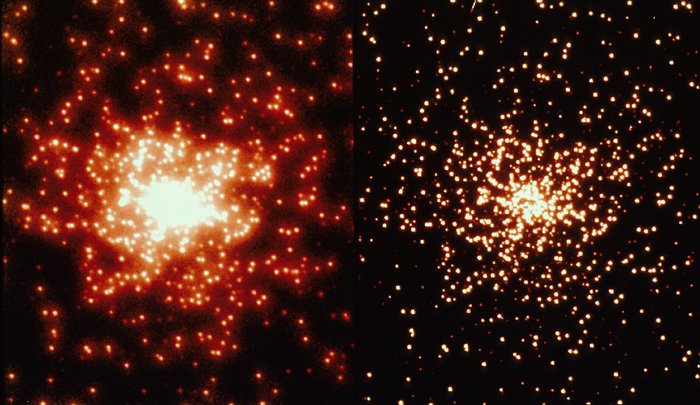Comparison of a WFPC2 thermal vacuum globular cluster-mask image to WFPC1
Right panel: Real image taken with the Wide Field/Planetary Camera-2 of a "globular duster" pinhole mask in the April 1993 WFPC2 Thermal Vacuum test at JPL (Pasadena, CA). The image is a 80 sec exposure through the F555W ("V") filter about 40x34" on a side, and approximates closely what HST+WFPC2 should see in a few-orbit exposure after refurbishment on a distant globular cluster (like Omega Centauri, but up to 70x further away). This HST image has a resolution of ~0.10 (FWHM), or about 10x sharper than can be ordinarily achieved from the ground. Note the apparent lack of spherical aberration wings in the expected refurbished HST image, and that individual stars can now be distinguished for the first time down to the very cluster center. The faint cosmic-ray streak in the middle of the left edge shows that this is a real (WFPC2) CCD-image.
Left panel: Simulation of the same globular cluster as in the right panel (shown at the same intensity scale), but as it would have appeared to WFPC-1 before HST's refurbishment. Note that most of the stars in the cluster center cannot be separated because of the spherical aberration wings in the pre-refurbishment HST images, and that all the faintest stars in the cluster outskirts have disappeared, because of spherical aberration and the higher read-noise in WFPC1. Note how similar this image is when compared to a real WFPC1 observation of the Galactic globular cluster M15 (see Lauer et al. 1991, Astrophysical Journal 369, Letter 45, Plate L11 and L12). Both show a central diffuse halo of starlight from HST's spherical aberration wings and a lack of faint stars.
Credit:About the Image
About the Object
| Name: | M 15, Messier 15, NGC 7078 |
|---|---|
| Type: | Local Universe : Star : Grouping : Cluster : Globular |
| Category: | Star Clusters |
Colours & filters
| Band | Wavelength | Telescope |
|---|---|---|
| Optical V | 555 nm |
Hubble Space Telescope
WFPC2 |
